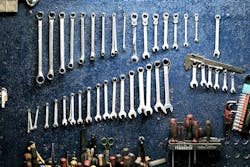Seasonal Service: A Moving Target
Attending group or association meetings with the automotive crowd allows me access to some of the best insights into what drives our robust domestic automotive aftermarket. You get a chance to sit and talk with diverse groups of store owners, shop mangers and their employees, each bringing their local and personal perspectives to the conversation.
My latest epiphany came at breakfast meetings with counter people from automotive stores all over North America. After one of the sessions, the subject of seasonal service came up, leading to a discussion of the evolution of this annual tradition and how much its meaning has changed in the last few years.
According to this group of automotive professionals, if you own a vehicle that is modern (10 years old or newer) there is an assumption of all-season motoring that assumes — other than snow tires or chains — the vehicle is ready for what Mother Nature will throw at it. For many drivers their day-to-day transportation gets no special treatment because the seasons are changing. In the Northern part of the country, they reserve that for their other car: 4X4s, their snowplow, hot rods or collectible cars. If you live in more Southern climates, the same thing occurs with hunting and fishing equipment: 4X4s and special interest vehicles — old and new. The same things are true if you live in the far West or the East coast.
Depending on where you live and your automotive passion, there is seasonal service occurring in some segment of the aftermarket pretty much year-round. The trick to successfully staying ahead of this other-car trend is providing support by using products designed to revive and restore, as well as storing the vehicle for its protection, depending on the situation, time of year and the specific vehicle needs.
Don’t get me wrong — the replacement of traditional parts and products like snow tires, wipers, batteries and fuel additives will always be a part of living where winters get wet and cold. Drivers today have great expectations when asked about the all-weather performance they feel is now engineered into new vehicles. But the focus on seasonal service and winterizing now falls to our other vehicles. We have become a multi-car culture with many people owning multiple vehicles used on an as-needed basis. Because these needs tend to be seasonal, they are the group of owners that use seasonal service solutions the most depending on their situation and, most often, their location.
It seems seasonal service solutions do have one thing in common; they tend to be specific to the area they are needed, and there is always a category of vehicle that is the target of these products and services. I heard a lot of stories from the counter guys about trucks, 4X4s and snowplows from the North and Midwest that are winter- or summer-only vehicles and spend six months of the year stored. Their needs, obviously, tend to be specific in terms of what needs to be done and when it needs to be done. The stores made sure they were heavy on stocks of fuel stabilizer products and critter repellants (surprised me, but it made sense). The guys from the Midwest went on to explain, “It doesn’t matter how long the fuel stays good if critters eat the wires and you can’t start it.” When I talked to the West and East coast guys, I was not surprised to find they were tuned into winter service for another specialized group of consumers. Skiers and winter sports enthusiasts always need their vehicles winterized, so the guys and gals with ski and snowboard racks on their AWD SUVs are always eager customers for seasonal service.
It seems like winter or seasonal-oriented service opportunities are everywhere, if you know how to identify them. My favorite story was from a guy from South Texas. His store sits close to a park popular with car enthusiasts that like to polish and detail their cars and trucks next to the local river. Because the weather is brutally hot during the summer, this does not start to happen until winter sets in. Then, the convertibles come out, and the park fills up. They sell lots of car care and detailing products, but only during the winter months.
I guess what I walked away from the conversation with was the perception that there is always a seasonal market — winter being a particularly big one — that can generate opportunities for sales and service if you can identify it and cater to it. It doesn’t matter if it’s stabilizing fuel, polishing cars, providing antifreeze, selling snow tires or repelling critters, if you can identify a need, you will identify a potential to offer sales and service. But, it’s probably going to be for that other car, and it’s going to be on a seasonal basis.
